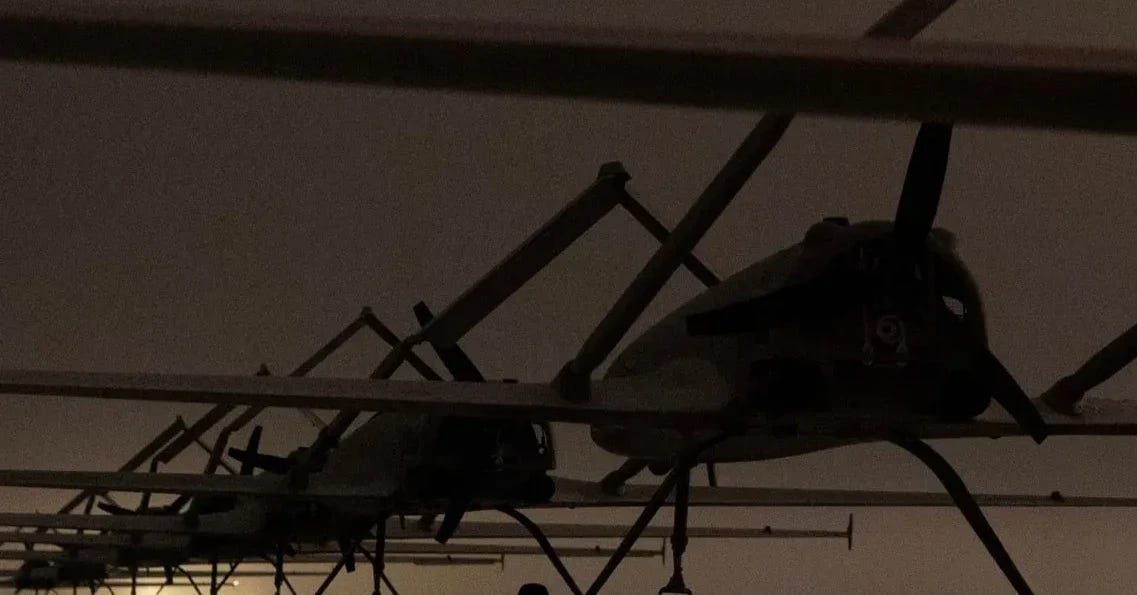Russia Hid a Munitions Plant By Blurring Images. Ukraine's Drones Blew It Up Anyway.
Attack drones struck the Izhevsk Electromechanical Plant, triggering a major blaze.
Ukraine’s best attack drones motored 800 miles to Izhevsk in central Russia on Tuesday and blew up the Izhevsk Electromechanical Plant, an important munitions factory. (See video above.) The resulting fire raged through the day.
The strike, reportedly orchestrated by the Ukrainian state security agency—the SBU—came exactly one month after the SBU notched its most successful raid in the 41 months since Russia widened its war on Ukraine.
On June 1, SBU agents smuggled more than 100 short-range explosive drones into Russia and struck four air bases, destroying 13 large warplanes including 11 irreplaceable Tupolev Tu-22M and Tupolev Tu-95 bombers and an equally irreplaceable Beriev A-50 radar plane.
Two weeks later on June 27, the SBU hit air bases in Crimea and southern Russia, reportedly destroying at least another seven Russian aircraft: four Sukhoi Su-34 fighter-bombers, three helicopters and potentially some drones.
The Izhevsk Electromechanical Plant is a juicy target. It’s not for no reason the factory is under foreign sanction. The plant is—or was, if the post-strike fire consumes it—“engaged in the development, production, operation and repair of Tor missile systems,” according to Open Sanctions.
The Tor is a medium-range air-defense system. Ukrainian forces routinely target Russian air-defenses—and the industry that produces them—in order to create safe corridors for attack drones. In that way, suppressing Russian air-defenses enables strikes on other targets.
The Russians may have known the Izhevsk strike was coming.
Shortly before the attack, the Russian government blurred imagery of the factory on Yandex Maps, Russia’s answer to Google Maps. But the blurring didn’t prevent the raid—and it may even have drawn attention to the munitions plant. “A military-grade example of the Barbra Streisand Effect,” quipped Tatarigami, the founder of the Ukrainian analysis group Frontelligence Insight.
“The SBU is systematically working to reduce the Russian Federation's capabilities to deliver air and bomb strikes on the territory of Ukraine,” the service explained in the aftermath of the June 27 raids. “The occupiers should realize that their expensive military equipment and ammunition are not protected anywhere: neither on the line of combat contact, nor in temporarily occupied territories, nor in the deep rear of the enemy.”
The SBU isn’t bluffing. Apparently spotting targets for long-range drones operated by the Ukrainian Unmanned Systems Forces, the SBU is attacking more often, deeper inside Russia—and inflicting more damage.
Farther-flying attack drones
The USF is deploying its new UAC FP-1 drones for many of the most damaging attacks. The FP-1 travels as far as 1,000 miles with a warhead weighing up to 250 pounds.
Ukrainian-Czech UAC extended the propeller-driven FP-1’s range and payload compared to older drones in part by omitting the landing gear. Instead of taking off on its own wheels, the FP-1 blasts off from an angled ramp, propelled by a fuselage-mounted rocket.
The new drone made its official public debut at a May exhibition in Kyiv. But production actually began last year. It complements or replaces Ukraine’s Aeroprakt A-22 drones, which are civilian sport planes modified for autonomous navigation.
The A-22s, each costing $80,000 or more before the addition of drone controls and warheads, were an awkward solution to Ukraine’s long-range strike problem. They’re designed to be manned planes and have voluminous cockpits. They are, in other words, overbuilt for what they do as drones.
That might explain why an A-22 or similar sport-plane drone evidently ranges just 800 miles or so with a 220-pound warhead. The FP-1, which might cost more than $100,000, should go farther with a similar payload.
On June 9, FP-1s flew more than 600 miles to Cheboksary in western Russia and blew up the VNIIR-Progress factory, which produced parts for S-400 air-defense batteries, tanks, fighting vehicles, drones, manned warplanes and warships.
Read more:
Ukraine's Best New Attack Drones Flew 600 Miles to Blow Up a Critical Defense Plant in Western Russia
On or just before Monday, Ukrainian drones motored more than 600 miles to blow up a factory in Cheboksary in western Russia.






